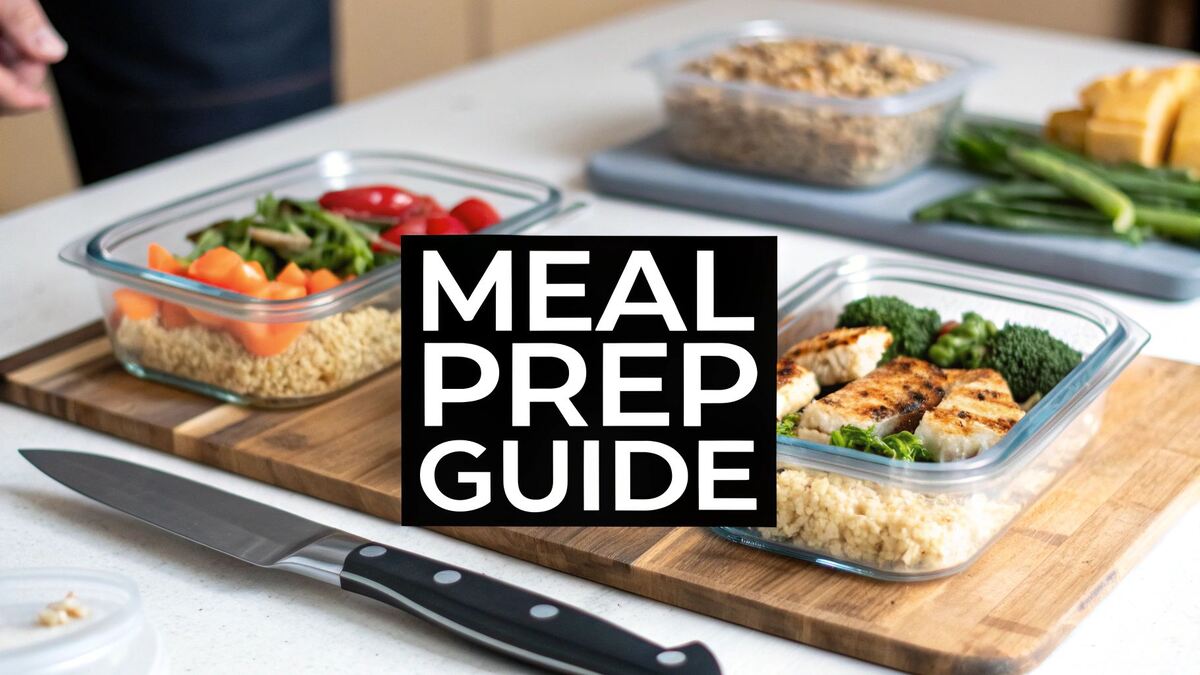Meal Prep for Beginners Your Simple Starting Guide
So, what is meal prep, really? At its core, it's the simple act of preparing meals or ingredients before you actually need them. This can save you a massive amount of time and stress during the week.
It’s a totally flexible system you can bend to fit your life. For some, it means cooking a full week's worth of lunches on a Sunday. For others, it’s just pre-chopping vegetables to make weeknight dinners come together faster. The main idea is to put in a little work upfront to make the rest of your week a whole lot smoother.
Why Meal Prep Is More Than Just a Trend
Let's be real—the thought of meal prepping can feel a bit intimidating. You're probably picturing a fridge packed with identical, perfectly portioned containers. But the truth is, it's way more practical and less rigid than what you see online. Think of it as building a simple habit designed to give you back your time and kill that daily "what do I eat?" indecision.
This isn't about some picture-perfect, Instagrammable lifestyle. It's about making your actual, real life easier. It’s your secret weapon against the 5 PM dinner panic. When you have food components ready to go, you stop reacting—grabbing whatever is fast and convenient—and start eating with intention.
Reclaim Your Time and Budget
One of the first things you'll notice is the impact on your bank account. When you have a plan, you walk into the grocery store with a purpose, which almost entirely eliminates those impulse buys. That focused shopping doesn't just save you money; it also cuts down on food waste because every single ingredient has a job to do.
Beyond the savings, you get back your most valuable asset: time. The couple of hours you might spend on a Sunday washing, chopping, and cooking can easily save you 15-30 minutes every single day. That adds up to hours of your week that are no longer spent over a hot stove or scrubbing pans.
The goal of meal prep isn't to create a rigid, boring menu. It's to create a system of convenience that makes healthy, intentional eating the easiest option available.
The infographic below shows how this simple process can take you from daily stress to a calm, organized week.
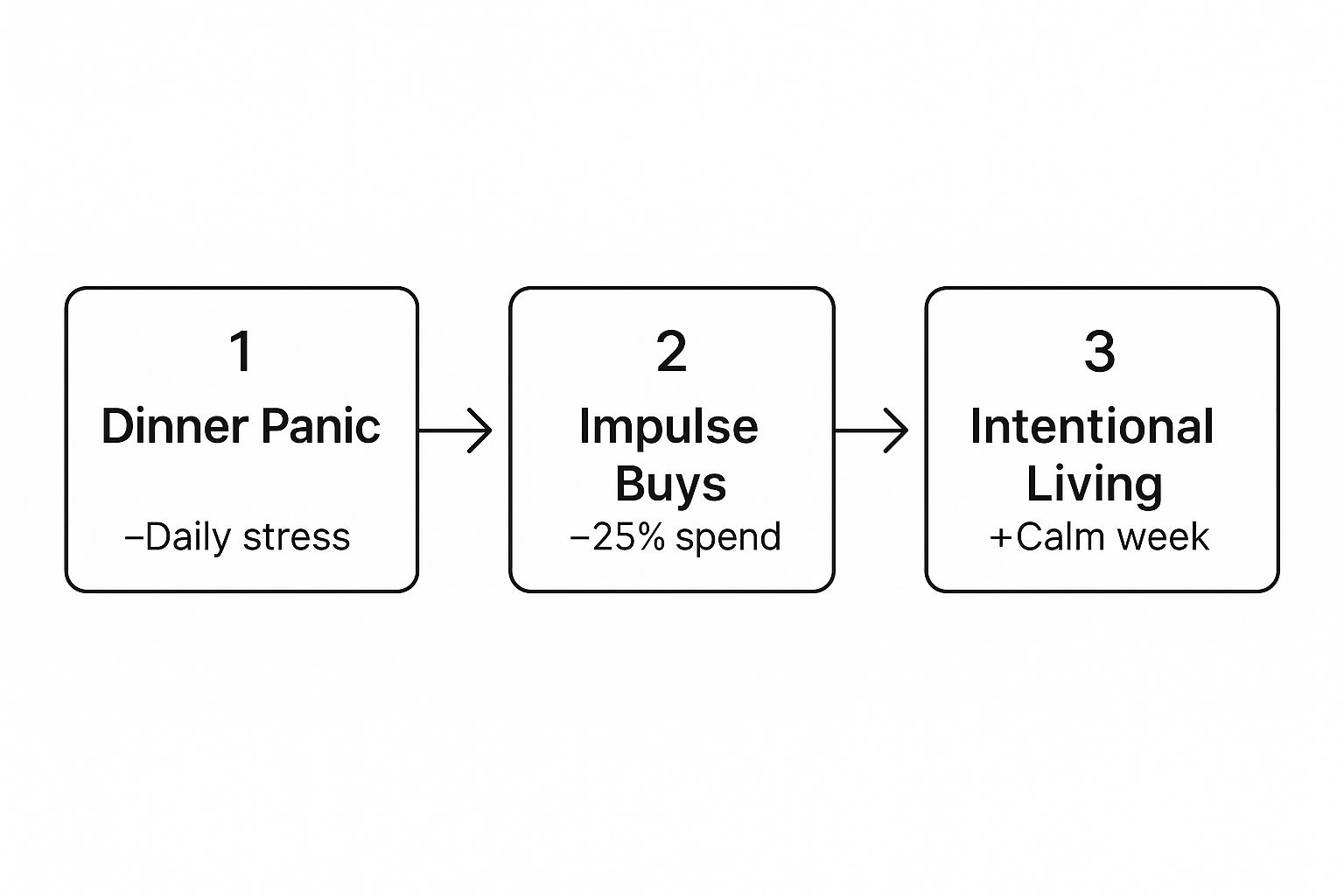
As you can see, it's a direct path from chaos to control. A little bit of planning makes a huge difference in your daily routine and your finances.
A Growing Movement Toward Intentional Eating
The popularity of meal prep isn't a fluke; it's part of a bigger shift in how we think about our health and manage our busy lives. The global meal prep market was valued at USD 5.68 billion and is projected to more than double by 2033. That's a pretty clear sign that people are looking for convenient, at-home ways to support healthier lifestyles. Discover more insights about meal prep market growth.
When you start meal prepping, you're not just organizing your food. You're laying the groundwork for a life that feels less stressful, healthier, and more deliberate. It's a small change that creates a powerful ripple effect.
If you want a hand getting started, check out our AI Meal Planner to get personalized plans that make the whole process even simpler.
Your First Meal Prep: A Realistic Game Plan
Getting started with meal prep doesn’t mean you have to lock yourself in the kitchen all day Sunday, packing away 21 sad, identical meals. Let’s be real—that’s a recipe for burnout. Forget the complicated spreadsheets and the all-or-nothing ambition.
The secret to making this a lasting habit is to start small. Make it feel easy, not like a second job.
A perfect first step? Just focus on three days of lunches. That's it. Nailing this small goal builds incredible momentum and proves that meal prep can be manageable and genuinely rewarding, right from the start. We're aiming for progress here, not perfection.
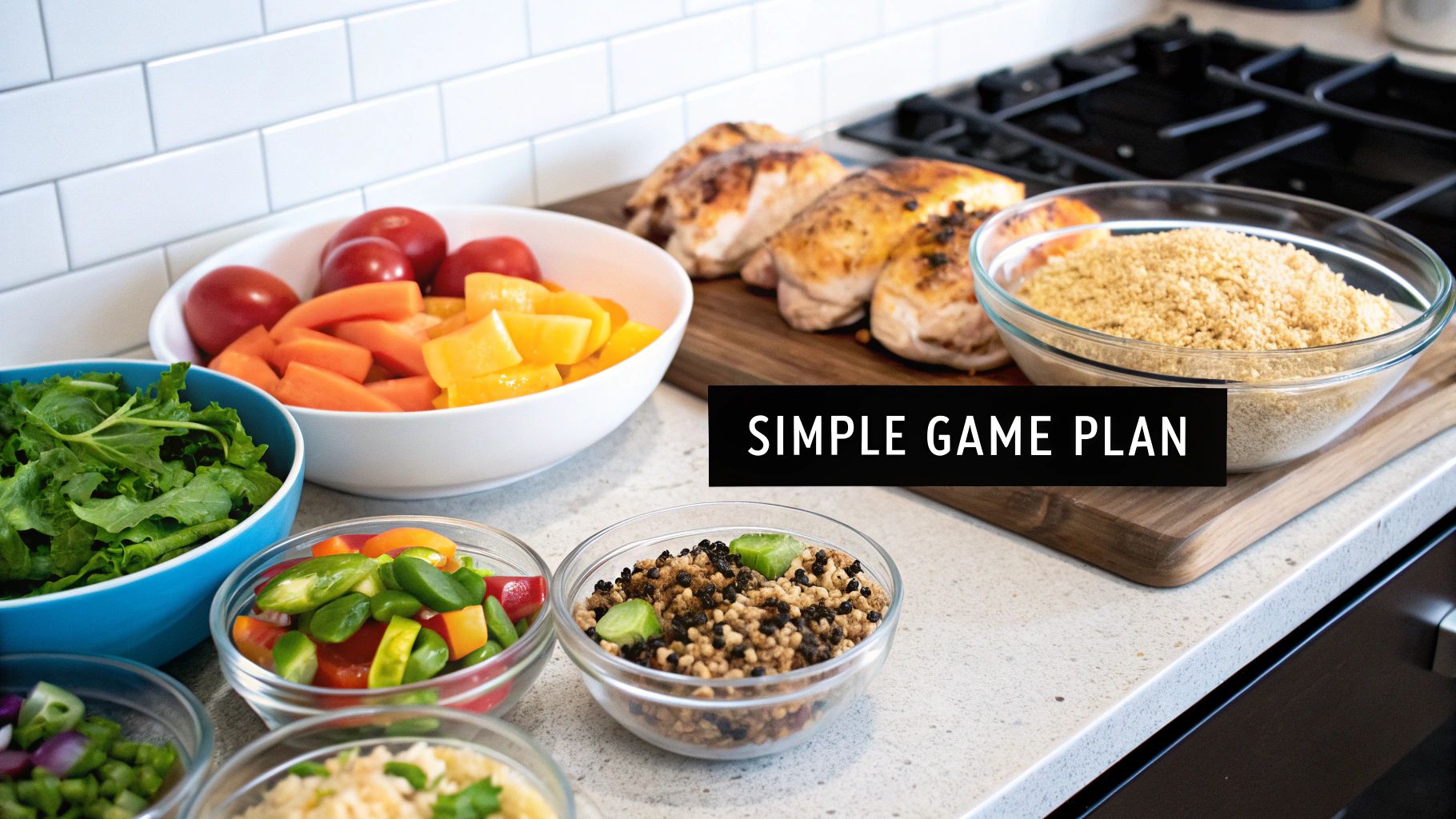
Embrace the "Component Prep" Method
Instead of assembling three complete, identical meals, I want you to think in terms of versatile building blocks. This is what I call the Component Prep method, and honestly, it's a game-changer for avoiding food boredom. You’ll just cook a few core ingredients separately, then mix and match them into different combinations throughout the week.
This approach gives you a ton of flexibility. One day you can throw together a quinoa bowl, the next a chicken salad, and the day after that, a veggie wrap—all using the same prepped components. It keeps your meals interesting and lets you adapt to what you're actually craving that day.
For a beginner, I’d suggest prepping a few simple things:
- A versatile protein: Think shredded chicken, a batch of lentils, or a few hard-boiled eggs.
- A hearty grain: Cook up a big pot of quinoa, brown rice, or farro.
- A mix of roasted vegetables: Broccoli, bell peppers, and sweet potatoes are fantastic because they hold up really well in the fridge.
- A simple dressing or sauce: A lemon vinaigrette or a tahini dressing can tie everything together beautifully.
Here’s a simple table to show you how this "component" idea works in practice. You cook the basics once, then assemble them differently each day.
| Beginner's Component Prep Plan | ||
|---|---|---|
| Component Category | What to Prep (Example) | How to Assemble |
| Protein | 1 lb shredded chicken breast | Day 1: Mix with grain, veggies, and dressing for a grain bowl. |
| Grain | 2 cups cooked quinoa | Day 2: Combine with chopped celery, onion, and a light mayo for a chicken salad. |
| Veggies | Roasted broccoli & bell peppers | Day 3: Roll up in a whole-wheat tortilla with a smear of hummus for a quick wrap. |
| Sauce/Dressing | Lemon-tahini dressing | Use it on the grain bowl, as a dip for the wrap, or to moisten the chicken salad. |
See how that works? It’s all about cooking smart, not just cooking more. You get variety without spending your entire weekend in the kitchen.
Choose Forgiving, Reheatable Recipes
The success of your first prep session really comes down to choosing recipes that taste just as good—or even better—on day three. Trust me, not all foods are created equal when it comes to reheating. Steer clear of anything that needs to be crispy, like fried foods or breaded cutlets. They almost always get soggy and disappointing.
Instead, lean into recipes that are built for reheating. These are your meal prep champions:
- Grain Bowls: The ultimate mix-and-match meal. It’s hard to go wrong here.
- Sheet-Pan Meals: Toss chicken or sausage with chopped veggies like broccoli, onions, and bell peppers. Roast it all on one pan for minimal cleanup.
- Soups and Chilis: These are perfect because their flavors actually deepen and get better after a day or two in the fridge.
If you’re looking for more ideas on how to structure your meals, you can find great inspiration in a balanced meal delivery plan, which shows how different ingredients can be combined for great flavor and nutrition.
Key Takeaway: The goal isn't just to cook food ahead of time; it's to cook food that you'll actually look forward to eating later. Stick with forgiving recipes to guarantee a delicious lunch every time.
Master Your Grocery Run and Time Block
Your meal prep session actually begins long before you turn on the oven. It starts with a smart, organized grocery list. Instead of a random jumble of items, group them by store section: produce, meat, dairy, and pantry staples. This one simple trick turns a wandering shopping trip into an efficient, in-and-out mission.
Once you have your ingredients, block out a specific time to cook. A two-hour window on a Sunday afternoon is more than enough for a beginner's component prep. Put on some music or a podcast and just focus on the task at hand.
Here’s how I’d structure that two-hour block:
- First 15 minutes: Wash and chop all your vegetables. Get your "mise en place" ready.
- Next 45 minutes: Get everything cooking. Put the grains on the stovetop and slide the sheet pans of veggies and protein into the oven.
- Final Hour: While things cook, you can whip up your sauce, wash the prep dishes, and portion out any cold items. Once everything is cooked, let it cool completely before storing it.
This structured approach makes the whole process feel calm and controlled. You're turning a potential chore into a productive and satisfying ritual. You’re not just cooking; you’re setting your future self up for a much less stressful week.
The Only Meal Prep Gear You Actually Need
It’s easy to get sucked into the idea that you need a kitchen full of fancy gadgets to meal prep. That’s probably one of the biggest myths out there. The truth is, successful meal prepping is built on a few reliable workhorses, not a drawer full of single-use tools you'll use once and forget.
The goal is to be smart about it. Invest in items that actually make your life easier without cluttering your counters or draining your wallet. Forget the spiralizers, sous vide machines, and avocado slicers for now. Let's focus on the absolute essentials that will make your prep sessions smooth and efficient.
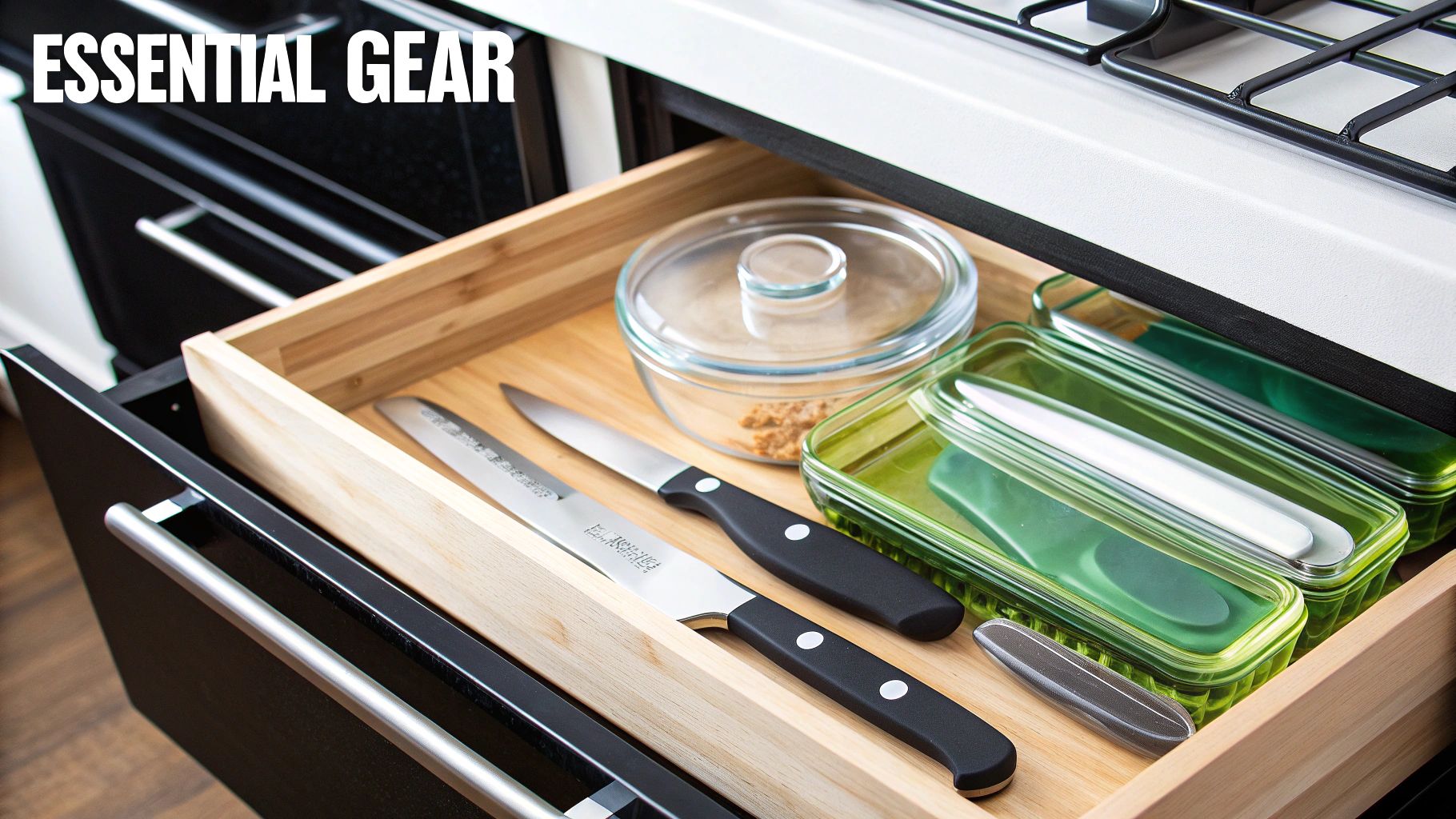
The Absolute Must-Haves
Think of this list as your starting lineup—the non-negotiables. These are the tools that will do 90% of the heavy lifting. Trying to meal prep without them is a recipe for frustration, and that's the fastest way to give up on a new habit.
- High-Quality Food Containers: This is where you don't want to skimp. I strongly recommend a good set of glass containers with airtight locking lids. They won't stain from tomato sauce, warp in the microwave, or hold onto odors from last week's salmon. Plus, having a matching set makes stacking them in the fridge incredibly satisfying.
- A Sharp Chef's Knife: A dull knife isn't just inefficient; it's a safety hazard. You really don’t need a whole knife block to start. One solid, 8-inch chef's knife can handle almost all your chopping, dicing, and slicing.
- Large Cutting Boards: Notice I said "boards," plural. You need at least two—one strictly for raw meats and another for produce. This is a dead-simple food safety practice that prevents cross-contamination. Look for boards that are easy to clean and won't slip around on your counter.
- Basic Cookware: You can get so much done with just a few key pieces. A large baking sheet is essential for roasting veggies and proteins. Add a stockpot for cooking grains and a skillet for sautéing, and you've covered nearly all your bases.
Smart Additions for Later
Once you get into a solid rhythm, you might find a few extra tools could streamline your process even more. These are the "nice-to-haves." They aren't necessary on day one, but they can be game-changers for taking your meal prep to the next level.
My best advice? Don't rush out and buy everything at once. Start with the must-haves. Only add a new tool when you consistently find yourself thinking, "Man, I really wish I had a..." This way, you only buy what you'll actually use.
When you're ready to upgrade your setup, consider adding these:
- A Food Scale: For anyone tracking macros or just trying to get consistent portion sizes, a food scale is a game-changer. It takes all the guesswork out of dividing up your meals, ensuring every serving aligns with your goals.
- A Slow Cooker or Instant Pot: These appliances are the champions of "set it and forget it" cooking. You can toss in ingredients for chili, soup, or shredded chicken in the morning and have a massive batch ready by the afternoon with almost zero effort.
- A Simple Food Processor: This little machine is amazing for whipping up sauces, dressings, and dips like hummus or pesto in a flash. It can also shred a whole block of cheese or a pile of carrots in seconds, saving you a ton of time and sore knuckles.
And while we're talking about containers, don't forget about staying hydrated on the go. It’s worth exploring the best insulated water bottles to keep your drinks cold (or hot) all day long. At the end of the day, the best gear is the gear you'll actually use week after week.
Keeping Your Prepped Food Fresh and Safe
The real win in meal prep isn’t just getting the cooking done. It’s pulling a perfectly fresh, delicious meal from your fridge on a busy Wednesday without a second thought. The success of your entire effort really boils down to one critical detail: how you store the food.
Get this part right, and your food stays tasty and, more importantly, safe to eat all week. A solid storage strategy is what keeps your hard work from going to waste, locks in all that flavor and texture, and gives you complete confidence in every meal you grab.
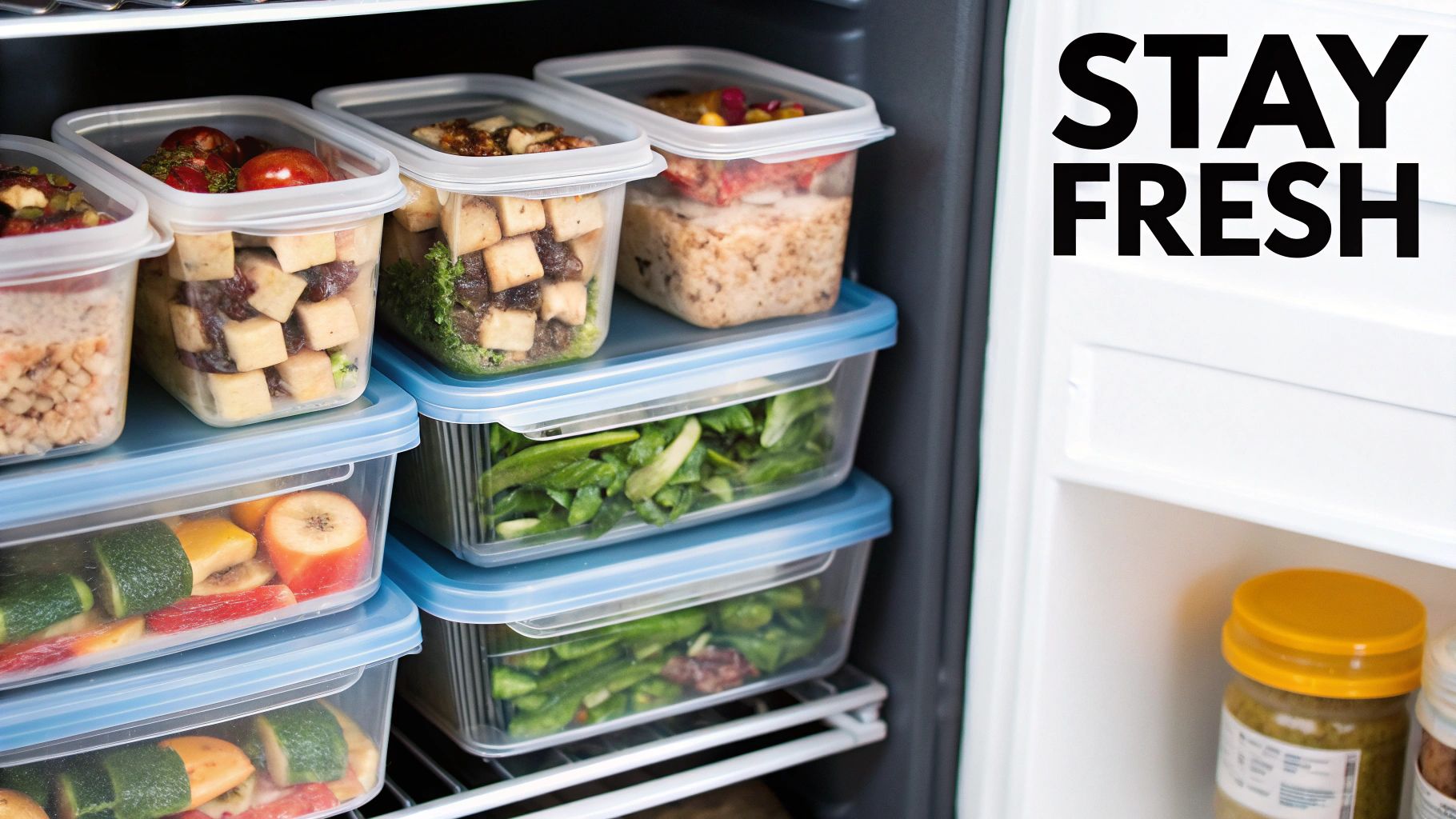
The Two-Hour Rule Is Non-Negotiable
One of the biggest food safety mistakes I see beginners make is packing piping hot food directly into containers and sealing them shut. This traps all the steam and heat, creating a warm, moist little incubator that bacteria absolutely love.
This is where the Two-Hour Rule becomes your best friend. You have to cool your cooked food down before it gets sealed up and stashed in the fridge. Bacteria thrive in the temperature "danger zone" between 40°F and 140°F, so your mission is to get your food through this range as quickly as possible.
An easy way to do this? Spread hot items like roasted vegetables or chicken breasts out on a baking sheet. More surface area means faster cooling. For big batches of soup or chili, don't just stick the whole pot in the fridge; divide it into smaller, shallower containers first. Once everything is cool to the touch, you’re good to portion, seal, and refrigerate.
Know What to Refrigerate and What to Freeze
Not everything you prep is meant to live in the fridge for five days straight. Figuring out what freezes well and what doesn't is a game-changer for any meal prepper. This lets you prep for the whole week (and beyond) without worrying about food going bad.
As a general guideline, most cooked foods are at their best for about 3-4 days in the refrigerator. If you're prepping on a Sunday, that means your Thursday and Friday meals should probably come from the freezer to ensure they’re still fresh and delicious.
Foods That Freeze Beautifully:
- Soups, Stews, and Chilis: These are my favorite freezer meals. The flavors actually get better after a little time together.
- Cooked Grains: Quinoa, brown rice, and farro all freeze and reheat like a dream. Just add a splash of water before you microwave to bring them back to life.
- Shredded Meats: Having portions of cooked chicken, beef, or pork in the freezer is a lifesaver for last-minute tacos or salads.
- Muffins and Cooked Oatmeal: Perfect for those grab-and-go breakfasts.
Foods to Avoid Freezing:
- High-Water-Content Veggies: Things like cucumbers, lettuce, and raw tomatoes will just turn into a sad, mushy mess when they thaw.
- Cream-Based Sauces: Dairy has a tendency to separate and get grainy when frozen.
- Fried Foods: That crispy coating you worked so hard for will become soggy and lose all its texture.
My rule of thumb is pretty simple: If it's a liquid or has a dense, cooked texture, it will probably freeze well. If it's supposed to be crisp and fresh, keep it out of the freezer.
This strategy—refrigerating for the next couple of days and freezing for later in the week—is the foundation of a successful meal prep routine.
A Simple Labeling System Is Your Best Friend
Trust me, after a few days, even your own cooking can become a mystery. What’s in that container? When did I even make this? You can avoid playing "mystery meal roulette" with a ridiculously simple labeling system. You don’t need a fancy machine—a roll of masking tape and a marker are all it takes.
On every single container, just jot down three things:
- What it is (e.g., "Chicken & Veggies")
- When you made it (e.g., "Made 10/27")
- Its destination (Fridge or Freezer)
This two-second habit saves so much confusion and helps you follow the "first in, first out" (FIFO) rule without even thinking about it. By labeling everything, you'll naturally grab the oldest meals first, which is the best way to prevent food from spoiling. It’s such a small step, but it makes a huge difference.
Adapting Meal Prep to Your Personal Goals
https://www.youtube.com/embed/AVO0ifle-OU
One of the biggest myths about meal prep is that it’s just a rigid system of chicken, broccoli, and rice. The reality is so much more exciting and flexible.
Think of meal prep less as a strict diet and more as a framework you can mold to fit whatever your personal health goals are. This is where you go beyond the basics and start making meal prep truly work for you. Whether you’re looking to lose weight, build muscle, or just get a healthy dinner on the table for your family, the core ideas of planning and prepping can be adapted. It all comes down to being intentional with your ingredients and portions to get the results you want.
Meal Prep for Weight Loss
When weight loss is your main objective, meal prep becomes an incredibly powerful tool for managing calories without making you feel deprived. The secret sauce is focusing on nutrient density and portion control. You'll want to prioritize foods that pack a lot of vitamins and minerals for fewer calories.
For starters, build your meals around these key components:
- Lean Proteins: Chicken breast, turkey, fish, and legumes are your best friends. They keep you feeling full and satisfied, which is crucial for kicking cravings to the curb.
- High-Volume Vegetables: Fill your plate with non-starchy veggies like spinach, broccoli, bell peppers, and zucchini. Roasting a huge tray of mixed vegetables is a perfect Sunday prep activity that gives you a versatile side for days.
- Complex Carbohydrates: Small, controlled portions of quinoa, sweet potatoes, or oats will give you that slow-burn, sustained energy you need.
To really dial in your results, it helps to understand different nutritional strategies. You can learn more about some of the most effective diets for weight loss and see how they can be woven into your prep routine. This is why you see a huge demand for convenient, calorie-controlled meal portions, often hovering between 350 to 550 calories. It just works.
Pro Tip: I always recommend using a food scale for the first few weeks. It might feel a bit tedious at first, but it’s hands-down the most accurate way to learn what a true portion size looks like and ensure you’re creating the calorie deficit needed for weight loss.
Prepping to Build Muscle
If you’re trying to build muscle, your meal prep strategy is going to look a little different. Here, we shift the focus to prioritizing protein and timing your carbs strategically. The goal is to give your body everything it needs to fuel tough workouts and then repair and grow those muscle fibers. This usually means eating larger portions and more frequently.
A solid muscle-building meal prep plan should include:
- High-Protein Components: Prep big batches of versatile proteins like grilled chicken thighs, lean ground beef, hard-boiled eggs, and Greek yogurt. You can easily add these to any meal throughout the week.
- Smart Carb Timing: Cook up plenty of rice, potatoes, and whole-wheat pasta. The trick is to portion these out to eat around your workouts, which is when your body can put that energy to the best use.
- Healthy Fats: Don't skip the healthy fats! Sources like avocado, nuts, and olive oil are essential for hormone production, which plays a big role in muscle growth.
For anyone serious about this goal, a structured plan is a game-changer. It's worth checking out a dedicated high-protein meal plan to get a feel for how meals are structured to maximize muscle synthesis and recovery.
Family-Friendly Meal Prep
Prepping for a family, especially one with picky eaters, requires a whole different playbook. The secret isn't to create a dozen identical, pre-portioned meals. It’s to embrace what I call "deconstructed" meal prep. This is all about prepping components that everyone can assemble themselves.
Think of it like setting up a mini buffet bar for dinner. This simple method empowers your kids (and your partner!) to build their own plates, which I’ve found dramatically increases the odds they'll actually eat the food without a fight.
A Deconstructed Taco Night Prep:
- Protein: Cook a large batch of seasoned ground turkey or black beans.
- Veggies: Finely dice tomatoes, onions, and lettuce. Go ahead and shred some cheese, too.
- Toppings: Portion out little containers of salsa, sour cream, and jalapeños.
- Carbs: Have both hard taco shells and soft tortillas on hand so everyone has an option.
When dinnertime rolls around, you just pull everything out of the fridge and let the family build their own tacos or taco salads. This works beautifully for grain bowls, pasta nights, and homemade pizzas, too. It’s a simple shift in mindset that can transform mealtime from a battle into a fun, interactive experience. Trust me, it saves your sanity and cuts down on food waste big time.
Still Have Questions? Let's Tackle Some Common Meal Prep Concerns
Jumping into any new routine feels a little awkward at first, and meal prep is no exception. It’s totally normal to have questions! Think of this as your personal FAQ, where we'll walk through the common hurdles that trip people up and give you the confidence to make this habit stick.
We’re going to get into the nitty-gritty of the most frequent worries I hear from beginners. From the dreaded food boredom to how much time this really takes, these answers are designed to keep you on track.
"But Won't I Get Sick of Eating the Same Thing?"
This is, without a doubt, the number one fear I hear. And it's a valid one! The good news? Avoiding food fatigue is way easier than you think. The real secret isn't to cook seven wildly different meals for the week.
It’s to prep ingredients, not just finished meals.
This is that component prep method we talked about, and it's your absolute best defense against monotony. Think of it as creating your own personal "build-a-bowl" bar for the week.
Roast a big pan of broccoli and sweet potatoes, cook up a batch of quinoa, and grill a few chicken breasts. With those simple building blocks, the possibilities are endless. Monday, you've got a grain bowl. Tuesday, you toss it all over some greens for a hearty salad. Wednesday, you wrap it up in a tortilla with some hummus. The core ingredients are the same, but the meal feels completely different.
Another total game-changer is having a couple of great sauces on hand. A simple lemon vinaigrette, a creamy peanut sauce, or a spicy yogurt dip can completely transform the exact same ingredients.
Your goal isn't to eat the same Tupperware meal five times in a row. It's to have versatile, pre-cooked components ready to assemble into fresh, interesting meals in just a few minutes.
My advice? Try adding just one new thing to your prep each week—maybe it's a different grain like farro or a new homemade dressing. It keeps things interesting without overwhelming you.
"How Much Time Do I Really Need to Set Aside?"
It’s so easy to picture meal prep as a full-day affair, chained to your kitchen every Sunday. That's a classic beginner misconception that leads straight to burnout. For someone just starting out, a focused two-hour window is more than enough.
You have to get the "all-or-nothing" mindset out of your head. Trying to prep every single meal for the entire week is a recipe for disaster.
Instead, start with a much saner goal.
Here’s a realistic starting point:
- Pick one meal: Just prep your work lunches for Monday through Wednesday. That's it.
- Keep it simple: Stick to one or two super easy recipes. Think sheet-pan chicken and veggies or a big pot of chili.
- Be efficient: Get your ingredients and recipes out on the counter before you start the clock. A little organization goes a long way.
You'll be amazed at how those two hours on a Sunday pay you back during the week. The time you save is great, but the mental energy you get back from not having to ask "What's for dinner?" is priceless.
"What Are the Biggest Mistakes I Should Avoid?"
Knowing where others have stumbled is one of the best ways to sidestep those frustrations yourself. Most beginners fall into one of three classic traps when they first start out. Let's make sure you're not one of them.
- Getting Way Too Ambitious: This is the big one. Trying to prep breakfast, lunch, and dinner for seven days right out of the gate is a one-way ticket to giving up. Start small. Seriously. Just mastering lunches for a few days will build the momentum you need to do more later on.
- Prepping the Wrong Foods: Not everything reheats well. Trust me on this. Anything that's supposed to be crispy (think breaded cutlets or fries) will almost always turn into a soggy, sad mess. Stick to forgiving foods like soups, stews, curries, grain bowls, and roasted vegetables. They taste just as good, if not better, the next day.
- Ignoring Basic Food Safety: This is a crucial one that’s easy to overlook. A common mistake is sealing a container of piping hot food and sticking it straight into the fridge. You have to let your food cool down on the counter first. Sealing it while hot traps steam and can keep the food in an unsafe temperature zone where bacteria love to grow.
By dodging these common blunders, you’re setting yourself up for a much smoother, more successful experience. Meal prep is a skill, and like any skill, it gets easier with practice. Give yourself some grace and focus on being consistent, not perfect.
Ready to take the guesswork out of planning? The AI Meal Planner creates personalized meal plans tailored to your goals and preferences, complete with grocery lists and easy-to-follow recipes. Start your customized plan today!
AI-powered nutrition
Get Your Personalized Meal Plan
AI creates the perfect meals for your goals, lifestyle, and taste.
Start Your Journej
